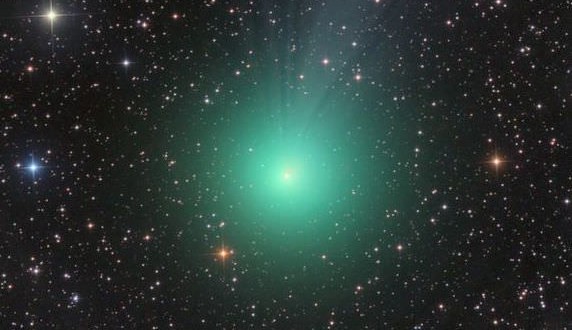It’s winter and it’s getting colder, but there are still good reasons to bundle up and enjoy the night sky. One reason is to catch a comet that is finally visible in Canada.
Comet C/2014 Q2 Lovejoy has brightened significantly since it was discovered in August. The coma, which is the atmosphere surrounding the icy nucleus, has grown and its tail has extended to about 229,000 miles (369,000 kilometers) as it nears its closest encounter with the sun at the end of January.
Comet Q2 is a very long-period comet that last passed through about 11,500 years ago. This visit will alter its path sufficiently to reduce that orbital period to about 8,000 years.
"Comet Lovejoy: "Gerald Rhemann took this picture on Dec. 21st [2014] using a remotely-operated telescope in Namib… pic.twitter.com/L8mJLUU5tr
— Stephen Johnston (@GLStephen) December 31, 2014
Amateur astronomer Terry Lovejoy found the comet from his Thornlands, Queensland, Australia home, his fifth cometary discovery. The comet was about 4,000 times dimmer when he discovered it just before dawn on August 17, 2014. Lovejoy is well known among comet hunters for his techniques in modifying digital cameras to record the infrared light needed to detect deep space objects.
Comet Q2 rises above the treetops by about 7 p.m. in the constellation Lepus. The easiest way to find it is to wait until after 10 p.m. when Q2 is higher in the sky and the much brighter star Sirius has risen sufficiently to guide you. The comet will appear as a fuzzy white puffball through a small telescope or binoculars, though long-exposure photographs have revealed the coma to have a greenish glow coming from diatomic C2 gas fluorescing in sunlight.
Look to the southeast for the constellation Orion and its belt of three stars topped by orangey Betelgeuse. Look for the star Rigel in Orion’s right foot and beneath for the bright star Sirius. Rigel, Sirius and the comet form a right triangle midweek. The comet will appear a bit higher until Jan. 7, when Sirius, Rigel and the comet appear in an roughly equally spaced line.
Look for a break from these overcast conditions late tonight with partly cloudy conditions Wednesday and Thursday nights. Clouds are expected to return over the weekend, but the comet is expected to brighten through its closest approach to Earth on Jan. 7.
Though next week may offer even better viewing of Comet Lovejoy, don’t wait too long for your first view. As astronomer David H. Levy points out “Comets are like cats: They have tails, and they do precisely what they want.”
Agencies/Canadajournal
 Canada Journal – News of the World Articles and videos to bring you the biggest Canadian news stories from across the country every day
Canada Journal – News of the World Articles and videos to bring you the biggest Canadian news stories from across the country every day



